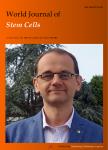Alternative splicing: An important mechanism in stem cell biology
Alternative splicing: An important mechanism in stem cell biology作者机构:The Vivian L Smith Department of Neurosurgery The Center for Stem Cell and Regenerative Medicine University of Texas Medical School at HoustonHouston TX 77030 United States
出 版 物:《World Journal of Stem Cells》 (世界干细胞杂志(英文版)(电子版))
年 卷 期:2015年第7卷第1期
页 面:1-10页
核心收录:
学科分类:1001[医学-基础医学(可授医学、理学学位)] 100101[医学-人体解剖与组织胚胎学] 10[医学]
基 金:NHLBI NIH HHS [R00 HL093213] Funding Source: Medline
主 题:Alternative splicing Stem cell Pluripotency Differentiation Splicing factor
摘 要:Alternative splicing(AS) is an essential mechanism in post-transcriptional regulation and leads to protein diversity. It has been shown that AS is prevalent in metazoan genomes, and the splicing pattern is dynamically regulated in different tissues and cell types, including embryonic stem cells. These observations suggest that AS may play critical roles in stem cell biology. Since embryonic stem cells and induced pluripotent stem cells have the ability to give rise to alltypes of cells and tissues, they hold the promise of future cell-based therapy. Many efforts have been devoted to understanding the mechanisms underlying stem cell selfrenewal and differentiation. However, most of the studies focused on the expression of a core set of transcription factors and regulatory RNAs. The role of AS in stem cell differentiation was not clear. Recent advances in highthroughput technologies have all owed the profiling of dynamic splicing patterns and cis-motifs that are responsible for AS at a genome-wide scale, and provided novel insights in a number of studies. In this review, we discuss some recent findings involving AS and stem cells. An emerging picture from these findings is that AS is integrated in the transcriptional and post-transcriptional networks and together they control pluripotency maintenance and differentiation of stem cells.



